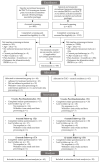Lessons Learned from an Attempted Pragmatic Randomized Controlled Trial for Improvement of Chronic Pain-Associated Disability in Green Professions: Long-Term Effectiveness of a Guided Online-Based Acceptance and Commitment Therapy (PACT-A)
- PMID: 36360738
- PMCID: PMC9655679
- DOI: 10.3390/ijerph192113858
Lessons Learned from an Attempted Pragmatic Randomized Controlled Trial for Improvement of Chronic Pain-Associated Disability in Green Professions: Long-Term Effectiveness of a Guided Online-Based Acceptance and Commitment Therapy (PACT-A)
Abstract
Musculoskeletal symptoms are increased in farmers, whereas the prevalence of chronified pain is unknown. Online interventions based on acceptance and commitment therapy (ACT) have shown encouraging results in the general population, representing a promising approach for reducing pain interference in green professions (i.e., farmers, foresters, gardeners). We conducted a pragmatic RCT comparing a guided ACT-based online intervention to enhanced treatment-as-usual in entrepreneurs, contributing spouses, family members and pensioners in green professions with chronic pain (CPG: ≥grade II, ≥6 months). Recruitment was terminated prematurely after 2.5 years at N = 89 (of planned N = 286). Assessments were conducted at 9 weeks (T1), 6 months (T2) and 12 months (T3) post-randomization. The primary outcome was pain interference (T1). The secondary outcomes encompassed pain-, health- and intervention-related variables. No treatment effect for reduction of pain interference was found at T1 (β = -0.16, 95%CI: -0.64-0.32, p = 0.256). Improvements in cognitive fusion, pain acceptance, anxiety, perceived stress and quality of life were found only at T3. Intervention satisfaction as well as therapeutic and technological alliances were moderate, and uptake and adherence were low. Results are restricted by low statistical power due to recruitment issues, high study attrition and low intervention adherence, standing in contrast to previous studies. Further research is warranted regarding the use of ACT-based online interventions for chronic pain in this occupational group. Trial registration: German Clinical Trial Registration: DRKS00014619. Registered: 16 April 2018.
Keywords: 12-month follow-up; 6-month follow-up; ACT; acceptance and commitment therapy; chronic pain; farmers; foresters; gardeners; internet intervention; randomized controlled trial.
Conflict of interest statement
Harald Baumeister (HB) reports to have received consultancy fees and fees for lectures/workshops from chambers of psychotherapists and training institutes for psychotherapists in the e–mental-health context as well as license fees for internet interventions from e-health companies. David Daniel Ebert (DDE) reports to have received consultancy fees/served on the scientific advisory board from several companies, such as Minddistrict, Lantern, Novartis, Sanofi, Schoen Kliniken, Ideamed, German health insurance companies (BARMER, Techniker Krankenkasse) and a number of federal chambers of psychotherapy. He is a stakeholder of the institute for health training online (GET.ON), which aims to incorporate scientific findings related to digital health interventions into routine care. Ingrid Titzler (IT) reports to have received fees for lectures/workshops in the e–mental-health context from training institutes for psychotherapists. She was research and implementation project lead of the trial site for the institute for health training online (GET.ON) for the European implementation research project ImpleMentAll (November 2017–March 2021), funded by the European Commission. All authors linked to the GET.ON institute (DDE, IT) had no influence over the analysis and interpretation of study results. The remaining authors (LB, YT, JF, JT) declare no conflict of interest. SVLFG had no role in the design of the study; in the collection, analyses, or interpretation of data; in the writing of the manuscript, or in the decision to publish the results.
Figures
References
-
- Husky M.M., Ferdous Farin F., Compagnone P., Fermanian C., Kovess-Masfety V., Scarth R.D., Stallones L., Zwerling C., Burmeister L.F., Thelin A., et al. Chronic back pain and its association with quality of life in a large French population survey. Health Qual. Life Outcomes. 2018;16:195. doi: 10.1186/s12955-018-1018-4. - DOI - PMC - PubMed
-
- Merskey H., Bogduk N. Classification of Chronic Pain. 2nd ed. IASP Press; Seattle, WA, USA: 1994.
Publication types
MeSH terms
Associated data
LinkOut - more resources
Full Text Sources
Medical
Miscellaneous



